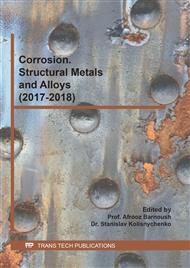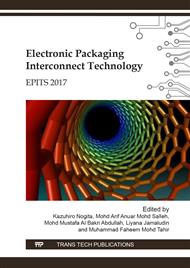[1]
F. Tian, P. J. Shang, and Z. Q. Liu, Precise Cr-marker investigation on the reactive interface in the eutectic SnIn solder joint,, Mater. Lett., vol. 121, p.185–187, (2014).
DOI: 10.1016/j.matlet.2014.01.170
Google Scholar
[2]
Y. Zhang, Tin and Tin Alloys for Lead-Free Solder,, Mod. Electroplat. Fifth Ed., p.139–204, (2011).
Google Scholar
[3]
M. Ishikawa, H. Sasaki, S. Ogawa, M. Kohinata, a. Mishima, and H. Yoshida, Application of Gold-Tin Solder Paste for Fine Parts and Devices," Proc. Electron. Components Technol. 2005. ECTC ,05., p.701–709, (2005).
DOI: 10.1109/ectc.2005.1441346
Google Scholar
[4]
C. M. Miller, I. E. Anderson, and J. F. Smith, A viable tin-lead solder substitute: Sn-Ag-Cu,, J. Electron. Mater., vol. 23, no. 7, p.595–601, (1994).
DOI: 10.1007/bf02653344
Google Scholar
[5]
X. Chen, A. Hu, M. Li, and D. Mao, Effect of a trace of Cr on intermetallic compound layer for tin-zinc lead-free solder joint during aging,, J. Alloys Compd., vol. 470, no. 1–2, p.429–433, (2009).
DOI: 10.1016/j.jallcom.2008.02.112
Google Scholar
[6]
M. F. M. Nazeri and et al., Effect of polarizations on Sn–Zn solders alloys in alkaline electrolyte,, J. Alloys Compd., vol. 606, p.278–287, (2014).
DOI: 10.1016/j.jallcom.2014.04.034
Google Scholar
[7]
L. Zhang and K. N. Tu, Structure and properties of lead-free solders bearing micro and nano particles,, Mater. Sci. Eng. R Reports, vol. 82, p.1–32, (2014).
DOI: 10.1016/j.mser.2014.06.001
Google Scholar
[8]
W. R. Osorio, E. S. Freitas, J. E. Spinelli, and A. Garcia, Electrochemical behavior of a lead-free Sn-Cu solder alloy in NaCl solution,, Corros. Sci., vol. 80, p.71–81, (2014).
DOI: 10.1016/j.corsci.2013.11.010
Google Scholar
[9]
M. Rasid, Z. Azwan, M. F. Omar, M. Nazeri, and M. Firdaus, Polarization Study of Sn-0.7 Cu Solder Alloy in 1M Hydrochloric Solution,, in Materials Science Forum, 2017, vol. 888, p.394–399.
DOI: 10.4028/www.scientific.net/msf.888.394
Google Scholar
[10]
M. N. Mohamed, N. A. Aziz, A. A. Mohamad, and M. F. M. Nazeri, Polarization Study of Sn-9Zn and Sn-37Pb Solders in Hydrochloric Acid Solution,, Int. J. Electroact. Mater, vol. 3, p.28–32, (2015).
Google Scholar
[11]
M. Firdaus, M. Nazeri, and A. Azmin, Corrosion resistance of ternary Sn-9Zn-xIn solder joint in alkaline solution,, J. Alloys Compd., vol. 661, p.516–525, (2016).
DOI: 10.1016/j.jallcom.2015.11.184
Google Scholar
[12]
Z. Ahmad, Basic Concepts in Corrosion. (2006).
Google Scholar
[13]
F. Rosalbino, G. Scavino, D. Macciò, and A. Saccone, Influence of the alloying component on the corrosion behaviour of zinc in neutral aerated sodium chloride solution,, Corros. Sci., vol. 89, no. C, p.286–294, (2014).
DOI: 10.1016/j.corsci.2014.09.007
Google Scholar



